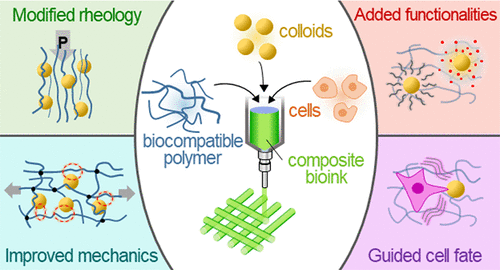当前位置:
X-MOL 学术
›
Biomacromolecules
›
论文详情
Our official English website, www.x-mol.net, welcomes your
feedback! (Note: you will need to create a separate account there.)
Hydrogel-Colloid Composite Bioinks for Targeted Tissue-Printing.
Biomacromolecules ( IF 5.5 ) Pub Date : 2020-06-22 , DOI: 10.1021/acs.biomac.0c00305 Raphaël Michel 1 , Rachel Auzély-Velty 1
Biomacromolecules ( IF 5.5 ) Pub Date : 2020-06-22 , DOI: 10.1021/acs.biomac.0c00305 Raphaël Michel 1 , Rachel Auzély-Velty 1
Affiliation

|
The development of extrusion-based bioprinting for tissue engineering is conditioned by the design of bioinks displaying adequate printability, shape stability, and postprinting bioactivity. In this context, simple bioink formulations, made of cells supported by a polymer matrix, often lack the necessary versatility. To address this issue, intense research work has been focused on introducing colloidal particles into the ink formulation. By creating weak cross-links between polymer chains, added particles modify the rheology and mechanical behavior of bioinks to improve their printability and structural integrity. Additionally, nano- and microscopic particles display composition- and structure-specific properties that can affect the cellular behavior and enhance the formation of tissue within the printed material. This Review offers a comprehensive picture of the role of colloids in bioprinting from a physicochemical and biological perspective. As such, it provides guidance on devising adaptable bioinks for the fabrication of biomimetic tissues.
中文翻译:

用于目标组织印刷的水凝胶-胶体复合生物油墨。
用于组织工程的基于挤压的生物打印技术的发展取决于生物墨水的设计,这些墨水具有足够的可印刷性,形状稳定性和印后生物活性。在这种情况下,由聚合物基质支持的细胞制成的简单生物墨水配方通常缺乏必要的多功能性。为了解决这个问题,集中的研究工作集中在将胶体颗粒引入油墨配方中。通过在聚合物链之间创建弱的交联键,添加的颗粒可改变生物油墨的流变性和机械性能,从而改善其可印刷性和结构完整性。另外,纳米和微观颗粒显示出特定于组成和结构的特性,可以影响细胞行为并增强印刷材料内组织的形成。这篇综述从物理化学和生物学的角度全面介绍了胶体在生物印刷中的作用。因此,它为设计适用于仿生组织的生物墨水提供了指导。
更新日期:2020-08-10
中文翻译:

用于目标组织印刷的水凝胶-胶体复合生物油墨。
用于组织工程的基于挤压的生物打印技术的发展取决于生物墨水的设计,这些墨水具有足够的可印刷性,形状稳定性和印后生物活性。在这种情况下,由聚合物基质支持的细胞制成的简单生物墨水配方通常缺乏必要的多功能性。为了解决这个问题,集中的研究工作集中在将胶体颗粒引入油墨配方中。通过在聚合物链之间创建弱的交联键,添加的颗粒可改变生物油墨的流变性和机械性能,从而改善其可印刷性和结构完整性。另外,纳米和微观颗粒显示出特定于组成和结构的特性,可以影响细胞行为并增强印刷材料内组织的形成。这篇综述从物理化学和生物学的角度全面介绍了胶体在生物印刷中的作用。因此,它为设计适用于仿生组织的生物墨水提供了指导。











































 京公网安备 11010802027423号
京公网安备 11010802027423号